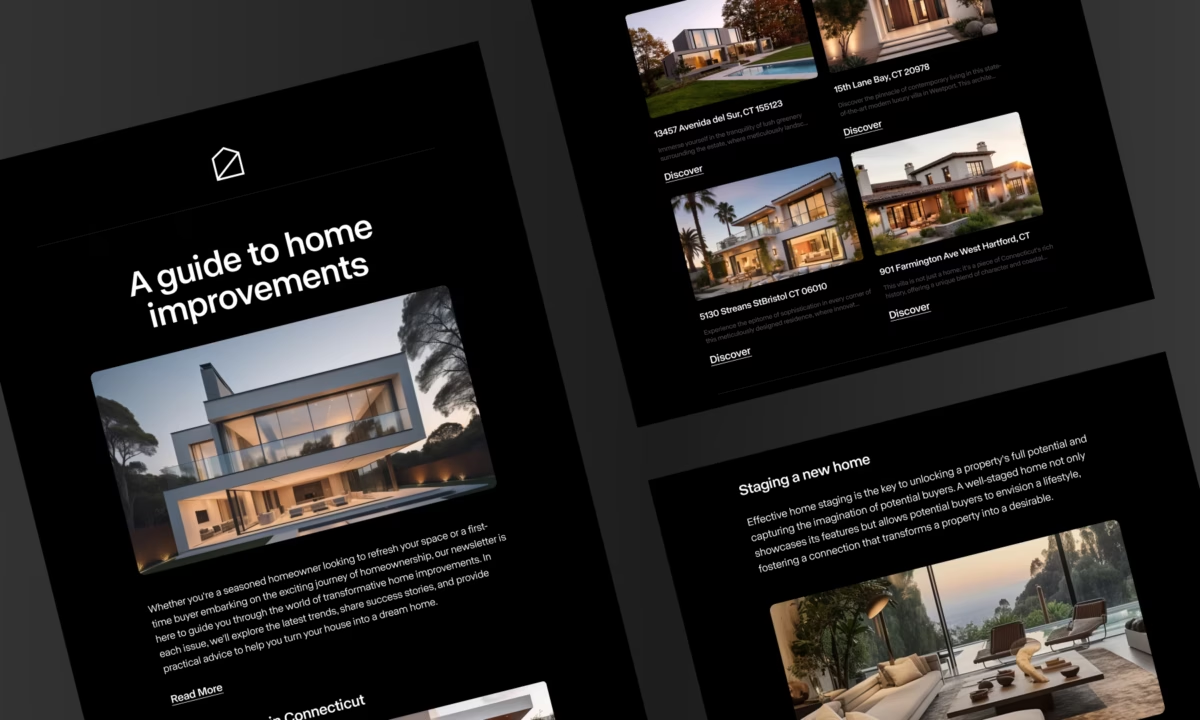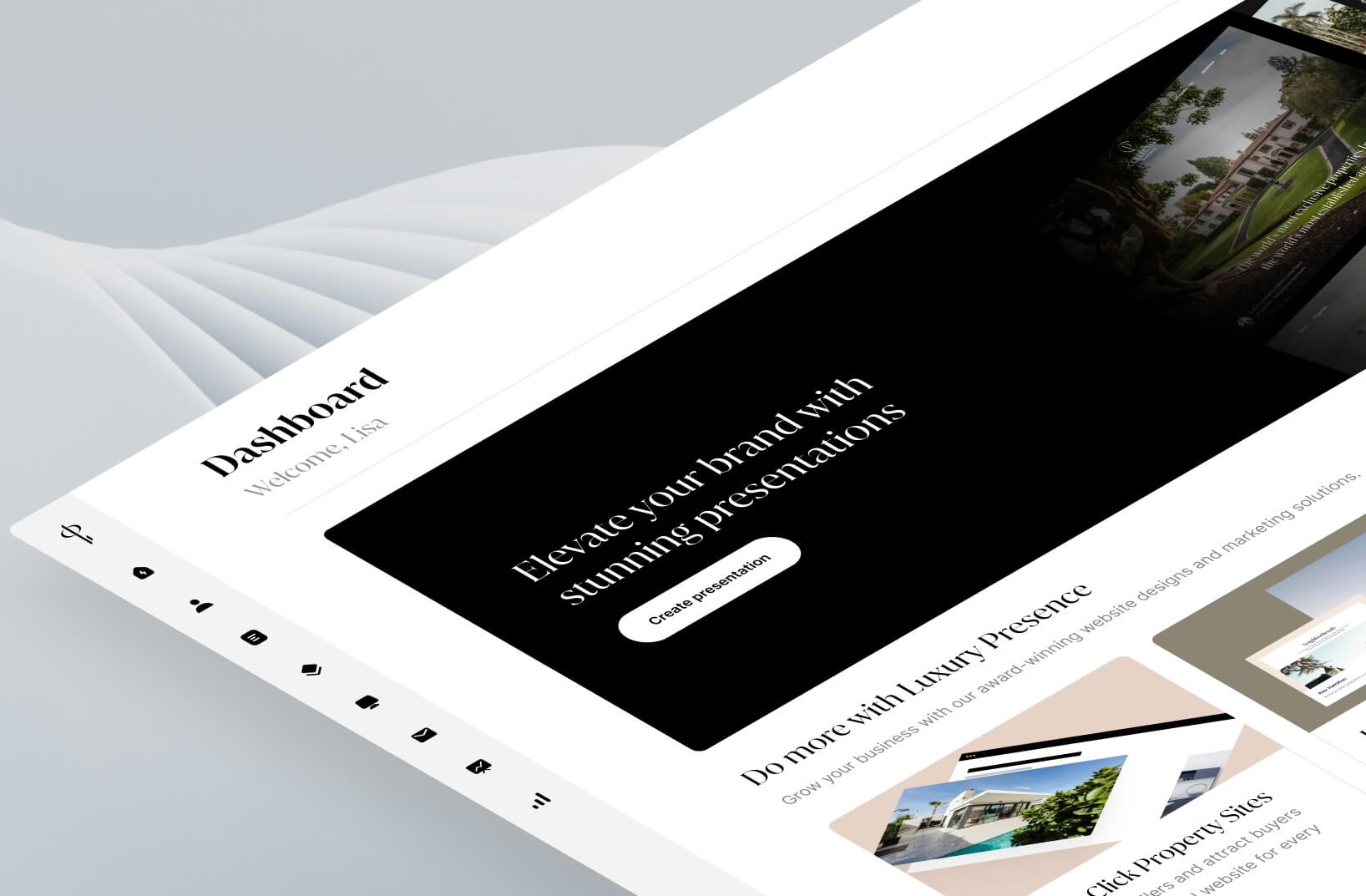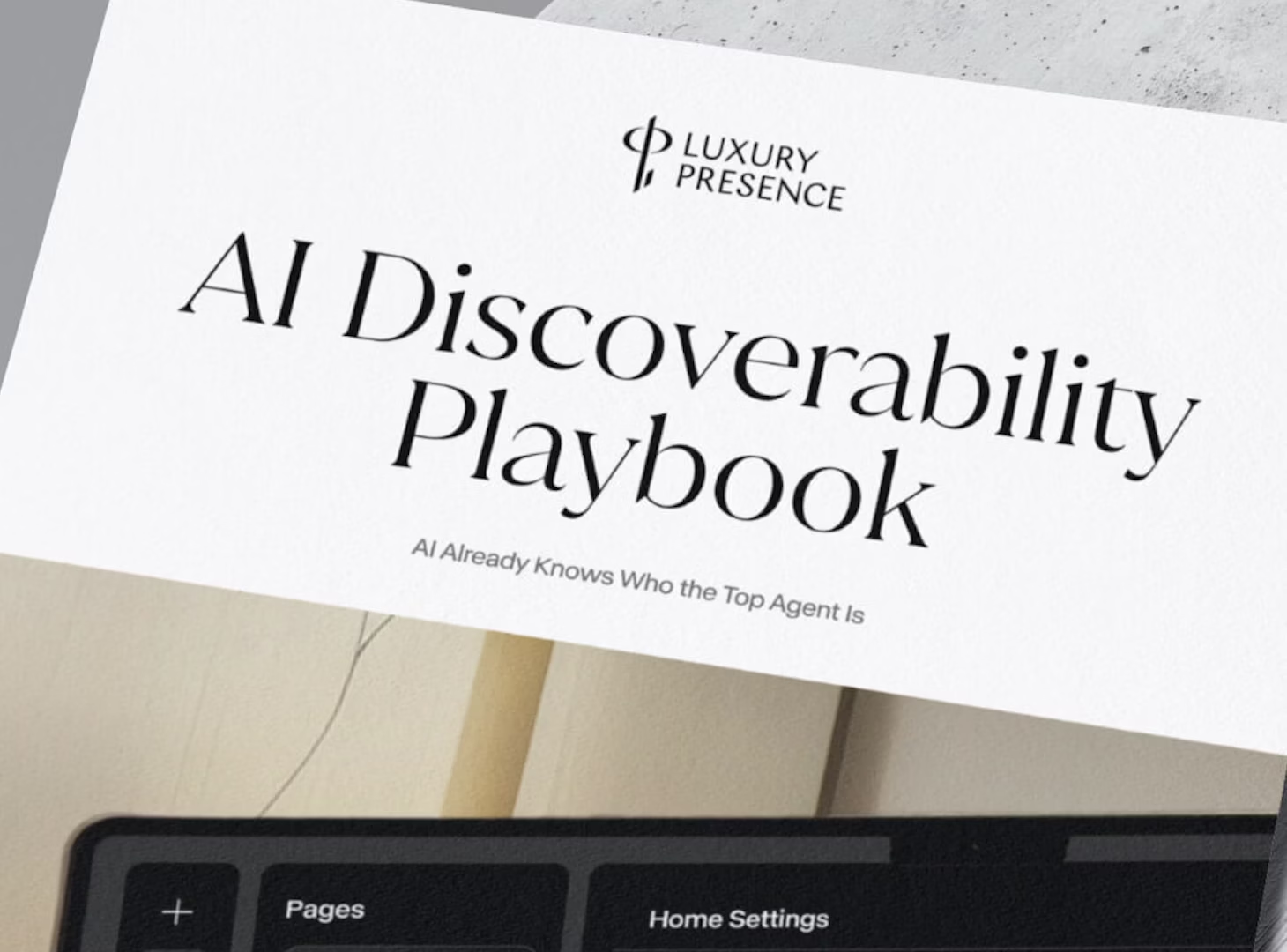
Find It Fast
AI Already Knows Who the Top Agent Is.
When someone asks ChatGPT, “Who’s the best luxury agent in Beverly Hills?,” it doesn’t give a list. It gives a name.
In test after test, that name is Jade Mills, not just because she’s successful, but because her digital presence is structured in a way AI can find it, trust it, and cite it.
This is the new reality: AI is now stands with Google search as the gatekeepers of online visibility, and it’s changing how buyers and sellers discover who to trust. The agents rising to the top in this new landscape are the ones being named by AI tools as the local authority. This playbook shows you how to make that happen.
You’ll learn how to structure content the right way, publish the formats AI prefers, and build the kind of digital presence that large language models (LLMs) surface first. In today’s AI-driven landscape, the most powerful position you can hold is being the answer to the question.
What You’ll Learn in This Playbook
This guide exists to make AI discoverability tangible, tactical, and achievable for real estate agents, regardless of your market or team size.
We’ll walk you through the core strategies that are already giving forward-thinking agents an edge:
- Run an AI-Optimized Website
(Because AI can’t cite what it can’t understand.) - Publish Unique, Data-Rich Content
(Fresh stats and local insights beat generic posts every time.) - Use Structured Formats and Citations
(Make your insights easier to “read” and trust.) - Earn Press Mentions
(AI values third-party credibility above all else.) - Stack Online Reviews
(Sentiment shapes AI output, and clients trust what it says.) - Bonus: Secure a Wikipedia Page
(It’s a training data source for nearly every AI model.)
Each section includes examples, step-by-step instructions, and tools to help you execute, along with behind-the-scenes insights from our team at Luxury Presence.
Find It Fast
Strategy One: Optimize Your Website for LLMs

TLDR: If AI Can’t Read You, It Can’t Recommend You
If your site isn’t optimized for LLMs, AI will skip over you entirely.
Most real estate agents think about SEO in terms of Google. And for good reason; Google still dominates traditional search. But AI assistants like ChatGPT, Claude, and Gemini don’t crawl the web in the same way. They read, interpret, and synthesize based on structure, clarity, and trust.
That means your website must be readable not just by people, but also by machines that think like people.
Before You Get Started: What Is an AI-Optimized Website?

An AI-optimized website is structured so that large language models (LLMs), especially those trained on or pulling from live web content, can easily read, interpret, and extract key information.
To be AI-optimized, a website should do the following (and, if these terms aren’t familiar to you yet, don’t worry, we’ll explain them in a minute):
- Use semantic HTML to clearly define content structure
- Include schema markup and structured metadata to provide context and relationships
- Present fact-based, scannable content with clear headings and formatting
- Maintain consistent, plain language to improve machine readability
Websites that follow these practices are far more likely to be referenced by AI when users ask about services such as real estate. If you work with Luxury Presence, these optimization strategies are already integrated into our website framework.
How to Ensure Your Website is Optimized for AI
So, what does it look like to put AI optimization into practice?
The following components are foundational elements of a complete strategy. Each one contributes to how effectively your website can be discovered, understood, and surfaced by large language models.
1. Structure Your Site for LLM Readability
AI doesn’t read content on your website the same way that a person would, or even the same way a search engine like Google does. LLMs such as ChatGPT crawl websites looking for indicators that your content could be a part of the best answer to someone’s question, specifically looking for things like:
- Semantic HTML
- Clean, indexable copy
- Plain language for key identifiers
- Internal linking structure
Ensuring your website utilizes these ensures Claude, ChatGPT, Perplexly, and others can read and understand your content.
Semantic HTML
Semantic HTML refers to the way your website content is structured in the backend, not how it visually appears to users. It’s about using correct HTML tags (like <h1>, <h2>, <p>, etc.) so that AI models can understand the hierarchy and meaning of your content.
While site visitors might only see clean headlines and text, large language models read the markup underneath to interpret which sections matter most and to extract meaningful facts.
AI models rely on semantic signals, especially headings, to identify topics, understand relationships between content blocks, and deliver concise answers in response to queries.
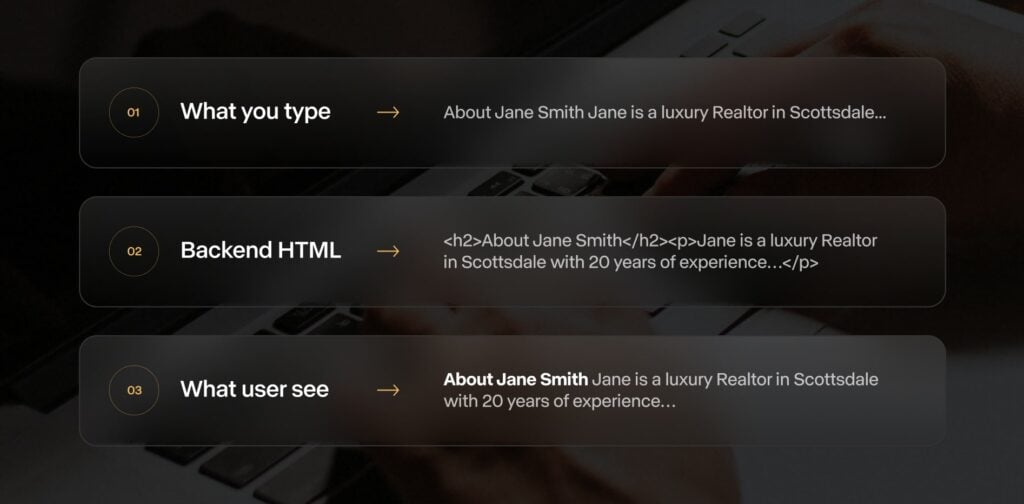
A page with semantic markup like <h2>About Jane Smith</h2> is far more digestible to an AI model than one relying only on bold text, large fonts, or decorative styling without proper structure.
Clean, indexable copy
Ensure key information, like your market focus, specialties, awards, and testimonials, is in text, not just images or video. If your homepage shows “Top 1% of agents nationwide” only as text inside an image, some AI won’t be able to read it because it can’t see images the way people do.

Plain language for key identifiers
Use exact terms that LLMs expect. Instead of “I help people find their dream space,” write “Jane Smith is a licensed real estate agent specializing in luxury homes in Austin, Texas.” Be literal. AI is sophisticated, but specificity still sells.
Internal linking
Cross-link between relevant pages on your site (from your homepage to your bio, from blog posts to your contact page). LLMs and search engines read linked structures as relationships between ideas and entities. This reinforces your authority within your domain.
2. Implement Schema Markup
Schema.org is the shared language AI uses to interpret structured web content. Adding this markup to your site is one of the most powerful (and most overlooked) steps you can take to improve AI visibility. Use Google’s free Structured Data Testing Tool to validate your schema and see what AI sees.
You (or your website platform such as Luxury Presence) can add schema manually in the site’s code using JSON-LD, or use plugins or built-in tools provided by your CMS (like WordPress or Webflow).
At a minimum, your site should include:
PersonorRealEstateAgentSchema- Include your full name, job title, location, areas served, brokerage, awards, professional affiliations, and contact information.
LocalBusinessSchema- Mark your real estate business as a local business with name, address, phone number (NAP), opening hours, service area, and geo-coordinates.
RevieworAggregateRatingSchema- If you feature testimonials or ratings, this schema helps AI understand your review footprint and quantify client sentiment, especially if it includes structured fields like star ratings.
3. Include Metadata That Summarizes Who You Are
Metadata is the invisible summary that tells AI what your pages are about. It’s how a model “knows” what your site offers without reading the full content. This includes:
- Title Tags: the headline that appears in browser tabs and search previews
- Meta Descriptions: a brief summary of each page, ideally under 160 characters
- OG (Open Graph) Tags: used by social and AI crawlers to generate previews
A homepage title like “Jane Smith | Top Luxury Realtor in Austin” and a meta description like “Award-winning Austin real estate agent specializing in lakefront homes and luxury estates.”
Most website builders (like WordPress, Squarespace, or Webflow) let you fill in these fields without touching code. Just look for the “SEO settings” or “page settings” area when editing your pages.
Adding metadata helps with SEO and makes it easier for AI tools to introduce or recommend you.
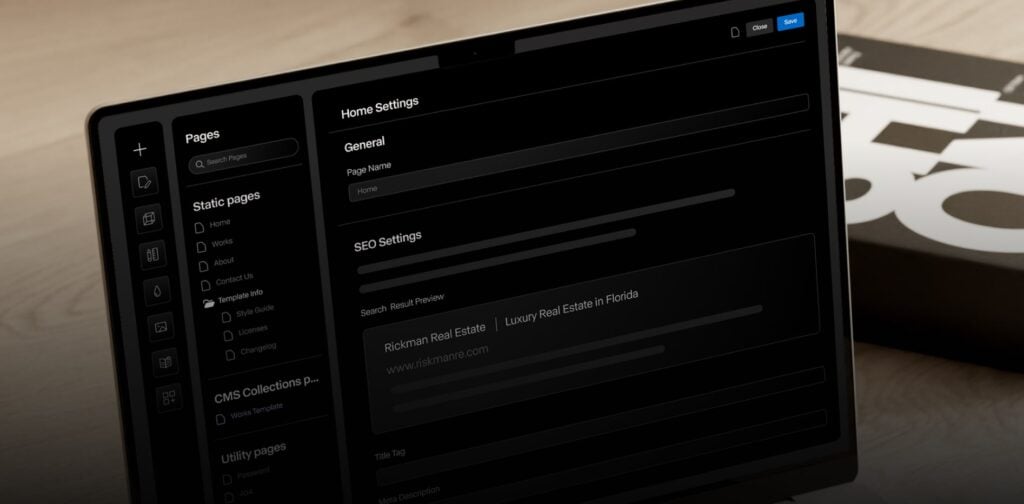
4. Remove AI Blockers From Your Site
Most websites have settings in their backend that contain a robots.txt file, a rule that governs what the bots that crawl the internet indexing content can see.
Some of these files haven’t been updated to allow AI-powered bots like GPTBot (OpenAI), CCBot (Claude), Bingbot, or Googlebot access. If that is the case, no matter how great the content on your website is, it will be invisible to LLMs.
Ask your developer or SEO team to check your robots.txt settings. You can test access using Google Search Console or OpenAI’s GPTBot guidelines. A few simple updates can make the difference between being ignored and being surfaced.
5. Optimize for Speed and Mobile
AI models often learn from search engine indexes and performance impacts indexability.
Google data shows that fast, mobile-friendly pages are a primary source for Google’s indexing and ranking decisions, and that page speed and mobile-friendliness are essential for search visibility and selection for features like snippets (a key AI training source).
Use tools like PageSpeed Insights or WebPageTest to find slowdowns, compress images, and prioritize responsive design.
These tools will scan your site and give you a score, along with specific suggestions. Focus on fixing:
- Slow Image Loading: Compress images using tools like TinyPNG or built-in CMS features
- Unused Scripts or Plugins: Remove anything your site doesn’t actively need
- Lack of Mobile Responsiveness: Make sure your site adjusts cleanly to smaller screens
- Missing Caching or Lazy-Loading: These features improve load times by only loading what’s needed, when it’s needed
If you’re on the Luxury Presence platform, you’re already ahead: Our websites are built to exceed Google’s Core Web Vitals benchmarks.
6. Feed AI the Facts Exactly as They Are
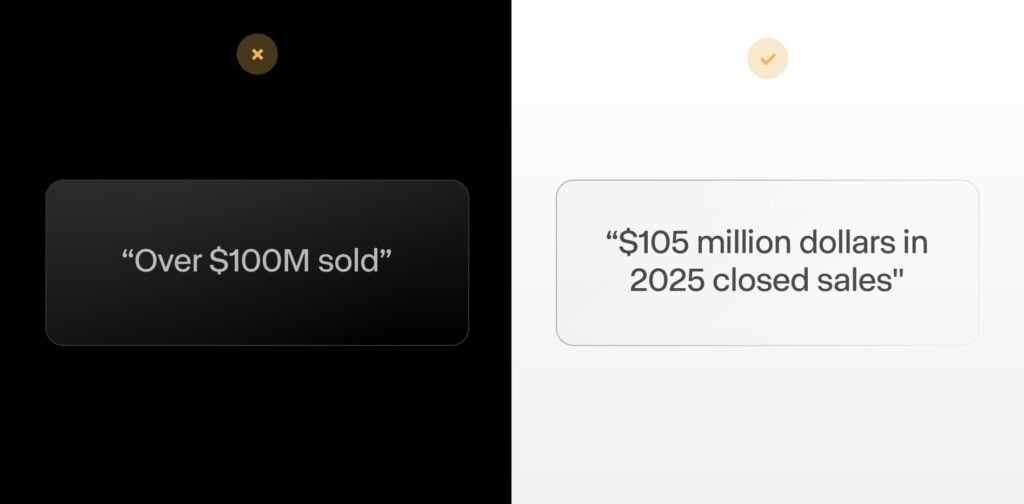
AI doesn’t infer or read between the lines. It takes what you write at face value and cites what’s clearly available.
So spell it out:
- Sold over $100M? Write the number.
- Specialize in Malibu beachfront properties? Say exactly that.
- Ranked #1 agent in your office in 2024? Include the title and the year.
Be specific. Be literal. Clarity leads to visibility.
The Bottom Line: Structure Drives Discovery
AI is hungry for clearly formatted, unambiguous information.
If your website is vague, templated, or technically inaccessible, you are invisible to the most important search tools of the next decade.
But if you’ve built a site that AI can read, and structured your presence like an authority, you position yourself as the clear, confident, trusted answer to client questions asked through AI.
Strategy Two: Publish Unique, Data-Rich Content

TLDR: AI Doesn’t Repeat What It’s Already Seen a Million Times
When ChatGPT recommends you, it’s not just because your website exists, but because your content says something fresh, specific, and timely.
Generic blog posts like “10 Tips for Staging Your Home” or “Why You Should Get Pre-Approved” are everywhere. AI has seen them a million times and skips over them.
If your content blends in, AI learns to ignore you. If it stands out, it starts to cite you.
To become discoverable, you need to create content that tells AI: “This agent has something original to offer. This is a source worth citing.”
Before You Get Started: Why Data-Rich Content Drives AI Visibility
LLMs are trained on billions of documents, and they’ve already seen every templated, syndicated, or boilerplate post out there. What stands out now are four things:
- Original, Local-Market Data
- Specificity Over Generality
- Structured, Well-Organized Insights
- Content That’s Regularly Updated
In short: Fresh Beats Familiar. Local Beats General. Data Beats Opinion.
LLMs are more likely to paraphrase or cite content that’s useful, timely, and clearly authored by a credible expert. The more specific your content, the more likely AI is to quote it and name you.
But what does this look like in real estate?

If a consumer asks Perplexity, “Is Now a Good Time to Buy a Luxury Condo in Dallas?” the model will look for content that:
- Mentions luxury condos
- References Dallas-specific trends
- Includes fresh data (e.g., Q2 2025 stats)
- Comes from a well-structured, trustworthy source
If your website includes a post like “Q2 2025 Luxury Condo Market Update – Uptown Dallas” that shares median prices compared to last quarter, listing volume, days on market, insights on buyer behavior or interest rates, and a clear takeaway for buyers or sellers, it’s far more likely to be recognized and cited by AI models as a valuable, credible source.
You become the model’s source.
Now add a chart, a table of recent sales, and a quote like:
“We’re seeing the highest absorption rate in Uptown since pre-pandemic. If you’re buying, speed matters.” – Jane Smith, Dallas Luxury Real Estate
That gives the AI:
- Timely, Structured Data
- Expert Commentary
- A Reason to Cite You in the Answer
How You Build AI Authority: One Specific, Well-Structured, Original Post at a Time.
These four content types are designed to meet all the criteria for AI visibility: originality, structure, local relevance, and expert insight.
Publish one strong, insight-rich post each month, such as a market update, local explainer, case study, or buyer’s guide. Rotate content types quarterly, and refresh evergreen posts as the market evolves. Within three to six months, you’ll build a trustworthy content library that increases your visibility in AI-driven answers.
1. Monthly or Quarterly Market Reports
Use your MLS access to highlight:
- Median sales price by property type and zip code
- Inventory trends (month-over-month and year-over-year)
- Average DOM and absorption rate
- Noteworthy off-market or luxury sales
Then, interpret the data. Don’t just list numbers, explain what they mean for buyers and sellers right now.
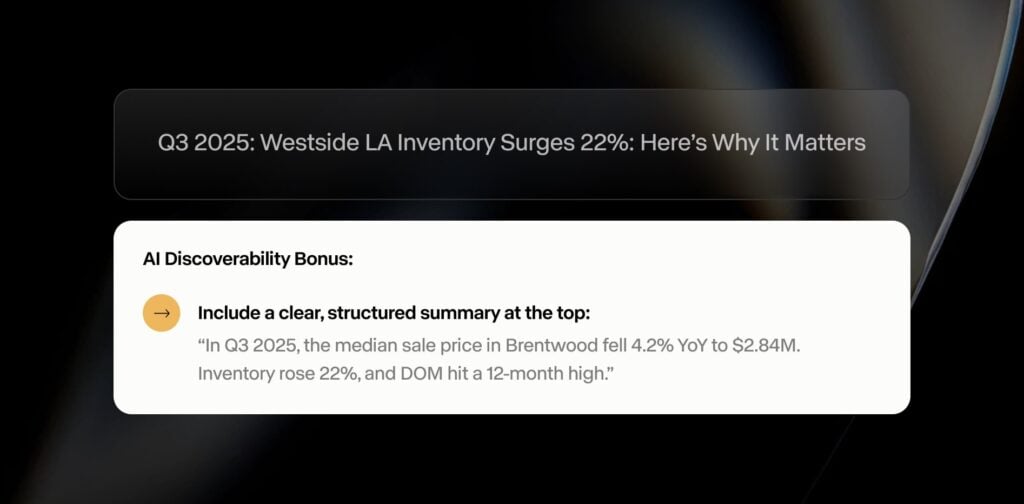
Example Title:
“Q3 2025: Westside LA Inventory Surges 22%: Here’s Why It Matters”
AI Discoverability Bonus:
Include a clear, structured summary at the top:
“In Q3 2025, the median sale price in Brentwood fell 4.2% YoY to $2.84M. Inventory rose 22%, and DOM hit a 12-month high.”
Models love summaries. Put them right where they can see them.
2. Topics Important to Your Local Community
LLMs like ChatGPT are increasingly asked to explain real estate markets, so they turn to deeply local content.
That’s your advantage.
Focus on the kinds of hyper-specific questions real clients actually ask:
- “How Do Homestead Tax Exemptions Work in Texas?”
- “Is It Better to List in April or June in Vail?”
- “What’s the Difference Between Balboa Peninsula and Corona del Mar for Oceanfront Buyers?”
These “niche but valuable” posts make up a significant share of long-tail AI queries. When you answer them well, with data, examples, and structure, your name starts appearing when models are asked for help in your market.
Then build out geographic guides that showcase your long-term market knowledge:
- “Moving to La Jolla: The Ultimate Guide for High-Income Buyers”
- “Silver Lake vs. Los Feliz: Which One’s Right for You?”
- “Where to Buy a Second Home in the Texas Hill Country (Based on 10 Years of Client Data)”
Include the details only a true local expert would know: Zoning quirks, walkability scores, tax considerations, sales velocity. That’s exactly the kind of context AI pulls from when synthesizing answers.
Make sure you interlink your content to create a web of connected information. The more original, place-based insight you publish, the more likely you are to become the name AI recommends in your market.
3. Transaction Case Studies
Turn standout sales into teachable moments. A case study should include:
- The property address (or neighborhood, if privacy matters)
- Time on market and final price
- Strategies used (timing, pricing, staging, negotiation)
- A specific challenge you overcame
Example Titles:
- “Case Study: How We Sold a $5.2M Home in 3 Days”
- “Case Study: $725K Townhome in Denver Sold with No Concessions in a Buyer’s Market”
- “Case Study: Rebranding a $3.4M Listing That Sat for 60 Days”
Include a section titled “Takeaways for Sellers” and bullet out 2–3 tactical lessons. This turns your win into reference material for an AI trying to explain what works in your market.
4. Client Surveys or Proprietary Insights
Create your own data: Even a small sample can be incredibly valuable to an AI.
Examples:
- “67% of Our 2024 Buyers Had Remote Jobs: Here’s How It’s Changing What They Want”
- “A Survey of 30 Sellers in Palo Alto Reveals What They Regret Most About Their Listing Strategy”
Run a Google Form survey to your email list or client base. Summarize the findings, include charts or quotes, and make it clear that the data is original to you.
If you’re using outside sources, cite the date of your data and where it came from (MLS, Zillow, NAR, Redfin, local tax assessor, etc.). Models favor transparency.
Use lists, tables, and charts wherever possible. AI ingests structured content more easily than long paragraphs. Use bullet points, numbered lists, and visuals (with descriptive captions) to segment your content.
The Bottom Line: The Right Content Wins
AI curates voices, and the voices they choose are the ones saying something unique, specific, and verifiable.
By publishing content that reflects your local expertise and original data and presents it in a way that LLMs can understand, you’re not just serving your human audience. You’re also making it easier for AI to identify and trust your expertise.
This is how your name starts showing up as a trusted source, how you begin to stand out as a true expert in your market, and how you build long-term visibility, one piece of content at a time.
Strategy Three: Use Structured Formats & Citations

TLDR: Clear Structure and Sources Earn AI Trust
Whenever someone asks ChatGPT or Claude a question, the model searches for fact-forward information that is logically structured and anchored in external validation. These models are trained to favor responses that look like answers.
Before You Get Started: The Data Supports What We Already Know
Studies find that AI models like Gemini are more likely to cite structured content, like Q&As or step-by-step lists, over long-form prose. These formats make it easier for AI to understand, trust, and reference your content accurately. Meanwhile, OpenAI’s own documentation confirms that GPTBot prioritizes web content that uses semantic structure, clear formatting, and identifiable citations to improve parsing efficiency and reliability.
How to Create Content That’s Easier for AI to Understand
Researchers analyzing GPT-4 and Claude’s source preferences found that answers were significantly more likely to be generated from web content that followed the patterns we outline here. Let’s break it all down, step by step.
1. Start with a Clear, Direct Answer
Every blog post, bio paragraph, or page section should lead with the value. Get to the point in the first sentence.
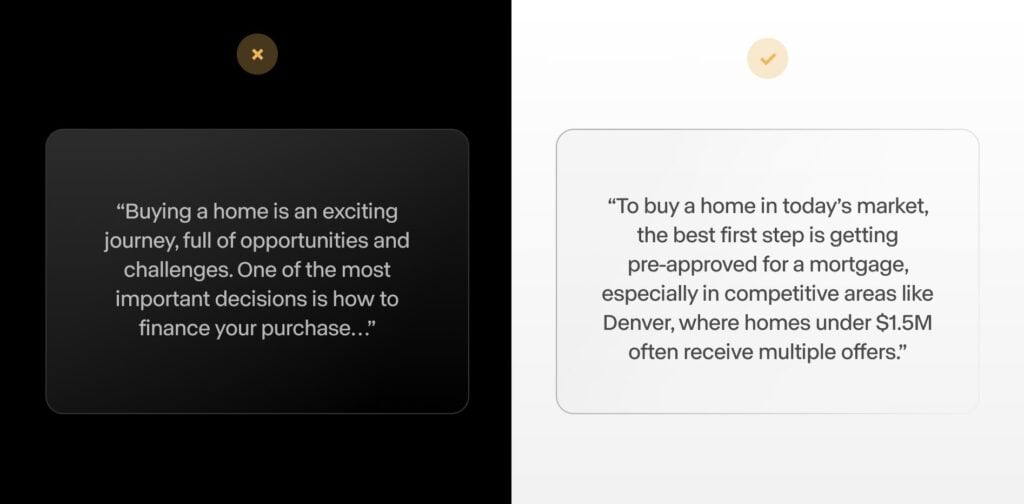
Example of what not to do:
“Buying a home is an exciting journey, full of opportunities and challenges. One of the most important decisions is how to finance your purchase…”
Example of AI-optimized content:
“To buy a home in today’s market, the best first step is getting pre-approved for a mortgage, especially in competitive areas like Denver, where homes under $1.5M often receive multiple offers.”
The first is filler. The second is an answer and one that a model might paraphrase or quote if asked, “What’s the first step to buying a home in Denver?”
This format aligns with Google’s “featured snippet” protocol, the exact content style that LLMs like ChatGPT, Gemini, and Perplexity are trained on.
2. Use Q&A Formatting to Mirror AI Patterns
Q&A is a natural and effective interface for AI assistants, especially for clarity and precision. When writing blog posts, landing pages, or service descriptions, using clear question headers followed by concise answers can make your content more accessible and appealing to language models.
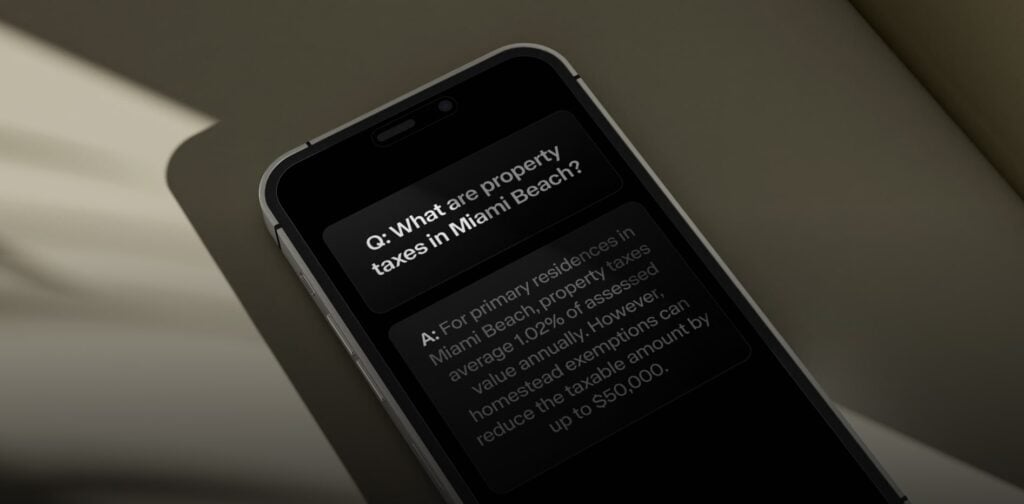
Example:
Q: What are property taxes in Miami Beach?
A: For primary residences in Miami Beach, property taxes average 1.02% of assessed value annually. However, homestead exemptions can reduce the taxable amount by up to $50,000.
This is what gets picked up in real AI answers.
Consider adding an FAQ section to:
- Your bio/about page
- Neighborhood landing pages
- Buyer/seller service pages
- Individual property listing descriptions
FAQ markup and format were among the most common content structures sourced by LLMs when responding to “local knowledge” questions (real estate, healthcare, education, law, etc.) in 2024.
3. Use Bullet Points and Numbered Lists for Skimmability
AI models prioritize content that is easy to scan and segment. Bullet points and numbered lists do three things exceptionally well:
- Encourage summarization, which is what models are built to do
- Break content into digestible ideas
- Imply hierarchy or sequence (which models understand)

Example:
Here are three reasons the Scottsdale market is tightening:
- Active listings dropped 18% year-over-year
- Mortgage rates softened slightly, improving buyer demand
- Inventory under $2M is down 24% from Q2 2024
This style of list is easily transformed into an AI output, especially when paired with a timestamp or citation.
4. Cite Your Sources and Become One
Models like ChatGPT and Gemini are specifically trained to trust content that cites other reputable sources. Cited content is considered more verifiable and therefore more likely to be referenced in AI outputs.
Because AI still struggles with accuracy, content that can be easily verified, through clear, credible citations, is more likely to be surfaced and repeated by AI.
When AI models see you referencing credible sources, they treat your site as part of that trusted network, boosting your chances of being pulled into answers, summaries, and recommendations.
How to use citations effectively:
- Link to official market data (e.g., NAR, Redfin, Freddie Mac, U.S. Census, local MLS dashboards)
- Provide source notes for all statistics and rankings
- Include links to news outlets or public records when citing events or notable sales
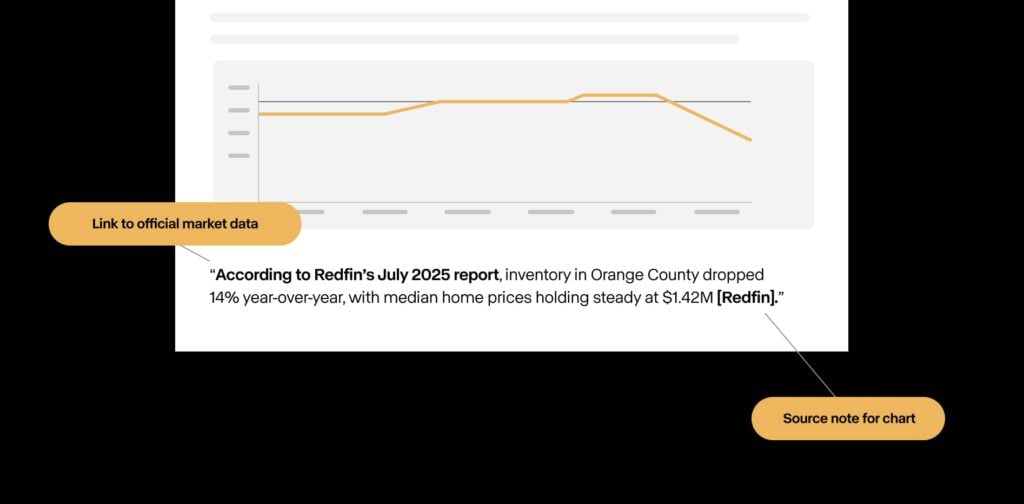
Example:
“According to Redfin’s July 2025 report, inventory in Orange County dropped 14% year-over-year, with median home prices holding steady at $1.42M [Redfin].”
Even better, embed citations using linked superscripts or footnotes, which AI models increasingly use as extraction signals or include a “Sources” section at the end of your posts. AI loves labeled structure and so do journalists and readers.
5. Use Named Entities Consistently
AI builds knowledge graphs: Webs of relationships between people, places, and data. Your goal is to be a named node in the graph.
To do that, you must use your name and market consistently in structured formats:
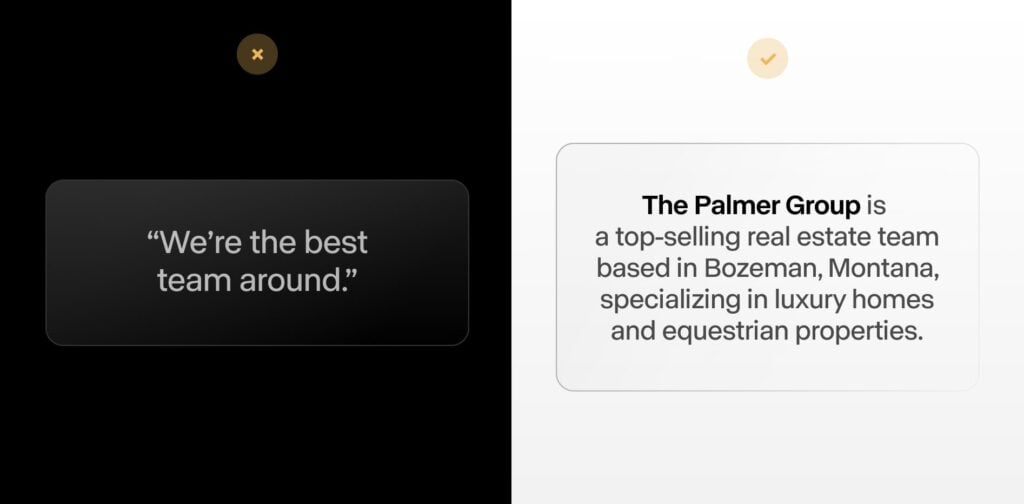
Consider: “We’re the best team around.” versus “The Palmer Group is a top-selling real estate team based in Bozeman, Montana, specializing in luxury homes and equestrian properties.”
Named entities (like “The Palmer Group,” “Bozeman, Montana,” and “equestrian properties”) are easier to index, easier to associate, and more likely to appear in answers, especially when used alongside citations or in structured formats.
6. Include Pull Quotes and Expert Callouts
LLMs are trained to extract and emulate expert opinions. You can become that opinion by formatting it clearly in your content.

Example:
“The number one mistake luxury sellers make is overpricing in a falling interest rate environment,” says Jason Lee, top-producing agent in Naples. “The market is responsive and unforgiving.”
This kind of pull quote makes you quotable. It mimics the kind of phrasing that AI naturally lifts into responses.
To get started, include one or two named quotes per post, formatted with bold or italic callouts. These are likely to be indexed as authoritative soundbites, especially if paired with a notable stat or observation.
The Bottom Line: Content That Aligns With AI Gets Amplified by AI
If you want AI to quote you, write like someone worth quoting. Because in this new digital landscape, the content that wins is credible, structured, and easy to reuse. It aligns with how AI thinks and how it speaks.
By formatting your content the way AI wants to read it, you give yourself an advantage: More visibility, more authority.
Strategy Four: Earn Press Mentions

TLDR: AI Believes What the Internet Says About You, Not Just What You Say About Yourself
In most AI-generated responses, whether from ChatGPT, Gemini, Claude, or Perplexity, the names that appear aren’t pulled from the agent’s website. They’re pulled from press citations and third-party mentions.
AI models are engineered to prefer what others say about you, not what you say about yourself.
If you want to be discoverable by AI, you need to be discovered by journalists, editors, publishers, and third-party sources first.
This is one of the highest-leverage moves you can make and one of the most misunderstood.
Let’s break it down.
Before You Get Started: How Press Mentions Influence AI Recommendations
Modern AI systems are trained on a massive corpus of public web content. That includes:
- Major news outlets (e.g., New York Times, Forbes, WSJ, The Real Deal)
- Local and regional news sites (e.g., Houston Chronicle, SF Gate, Miami Herald)
- Industry publications (e.g., Inman, RISMedia, RealTrends)
- High-authority blogs and ranking sites
- Wikipedia and Wikidata
- User-generated content with strong engagement (e.g., Reddit, Quora, LinkedIn posts)
Within that training data, LLMs are taught to weigh reputation signals and mentions of people, companies, and brands in third-party, independent contexts, which are higher than self-authored content.
OpenAI’s documentation confirms that GPT-4’s training data includes publicly available and licensed content from across the internet, including news articles, reference data, and domain-specific publishers.
Named entities (people or brands) mentioned are much more likely to appear in ChatGPT-generated responses when answering expertise-based questions.
That means a single article in Inman or RealTrends, or even a quote in your local business journal, can dramatically increase your chance of being cited or recommended by AI.
When LLMs encounter a pattern, a name cited in multiple reputable sources, described with authority, and linked to specific expertise, the model builds a confidence graph and you’re no longer just a website. You’re an entity with digital credibility.
How to Get the Press Mentions That Matter
You don’t need a publicist to start earning the kind of citations that AI models respect. You need:
- Original data
- A compelling narrative
- Persistence
- The right pitch at the right time
Here are four strategies that work for real estate professionals:
1. Become a Local Market Source
Newsrooms are understaffed and constantly looking for quotable experts, especially on housing, one of the most covered beats in the country.
Tactic:
Reach out to real estate, business, or local economy reporters at your metro paper or local NPR station. Offer to be a source for stories on home affordability, luxury trends, investor activity, or tax impacts.
Include:
- Your title, market, years in business
- A sample quote or stat you can offer
- A unique angle you’re seeing from the ground
Example Email Subject Line:
“Luxury Inventory Is Up 42% in Q3 — Happy to Share What I’m Seeing”
Journalists love experts who pitch insight. And one good quote can yield a high-authority article that AI will definitely notice.
2. Use HARO or Qwoted to Get Quoted
Platforms like Help a Reporter Out (HARO) and Qwoted match journalists with sources. They publish daily queries like:
- “Looking for agents with experience working with luxury international buyers”
- “Seeking commentary on mortgage lock-in effect from real estate professionals”
- “Need data or anecdotes about cash buyers in competitive markets”
Respond quickly and insightfully. Keep your bio short and facts sharp. The resulting quote, often in an outlet like Bankrate, Yahoo Finance, or Apartment Therapy, will live on the open web, accessible to crawlers and future LLM updates.
3. Write Thought Leadership for Industry Media
Many real estate publications accept contributed articles from experienced professionals.
Targets:
- Inman (guest columns, perspectives)
- RISMedia (industry voices)
- HousingWire, REALTOR® Magazine, Mansion Global (trend pieces)
- Your brokerage blog or national marketing platform
Great Topics:
- “5 Things Top Buyers Are Asking About in Today’s Market”
- “What We Learned From $100M in Sales in One Zip Code”
- “The Biggest Pricing Mistakes Luxury Sellers Still Make”
If your brokerage has PR support (e.g., Sotheby’s, Compass, Coldwell Banker), talk to your marketing team, many have pre-existing media relationships or syndication channels.
4. Issue Real, Newsworthy Press Releases
A well-crafted press release can result in dozens of authoritative mentions, and it gives you a chance to control your narrative in a format that AI systems are trained to trust.
Use cases:
- Record-breaking sale
- Expansion into a new market
- Recognition or award
- Launch of a new platform, app, or marketing campaign
Where to distribute:
- PR Newswire (most reputable)
- Business Wire
- Newswire (affordable, SEO-optimized)
Many press releases are indexed in Google News, added to market-watch aggregators, and scraped by LLMs, particularly if they’re rich in facts, quotes, and citations.
AI models prefer releases with “hard news” formatting: quote → stat → implication → source. Keep it professional, factual, and non-hypey.
Extend the Life of Your Media Coverage
Once you earn a press mention, do these four things immediately:
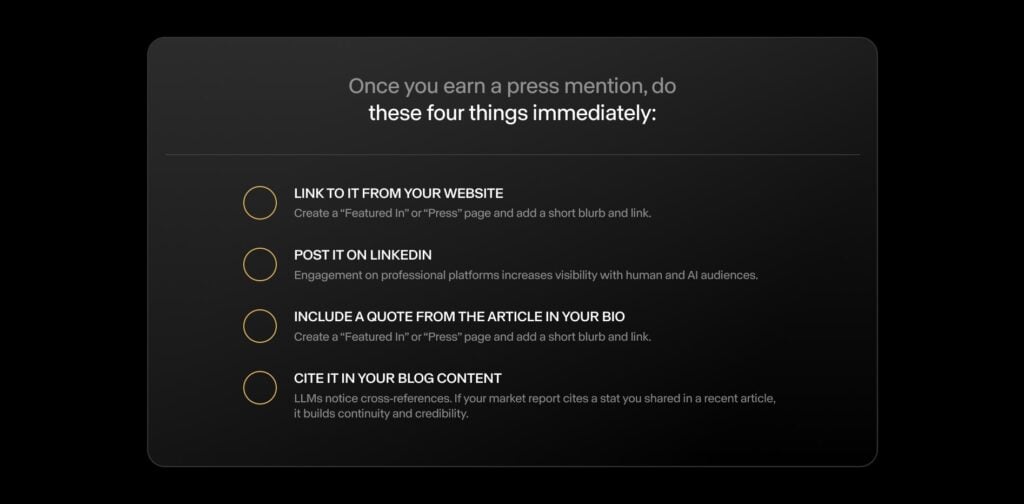
- Link to it from your website
Create a “Featured In” or “Press” page and add a short blurb and link. - Post it on LinkedIn
Engagement on professional platforms increases visibility with human and AI audiences. - Include a quote from the article in your bio
E.g., “Named a ‘standout strategist’ by Inman in 2024.” - Cite it in your blog content
LLMs notice cross-references. If your market report cites a stat you shared in a recent article, it builds continuity and credibility.
The more connected your mentions are across platforms, site, socials, search, media, the more cohesive and visible your digital footprint becomes.
The Bottom Line: Borrowed Trust Becomes Search Power
The strongest signals come from sources the internet already trusts: Journalists, editors, and third-party publications.
By earning even a few credible press mentions and anchoring them to your digital presence, you give large language models the confidence they need to recommend you. To present you as the answer.
This is one of the highest-leverage moves in the AI Discoverability Playbook because it allows you to leverage borrowed trust at scale. You’re no longer just a voice. You’re a verified one.
Strategy 5: Stack Up Positive Online Reviews

TLDR: AI Listens When the Crowd Speaks Clearly
In real estate, your reputation precedes you. In AI, your reputation trains the algorithm.
Public reviews on platforms like Google, Zillow, Realtor.com, Facebook, and Yelp have long been a Strategy of social proof for prospective clients. But now, they also serve large language models.
Every 5-star review, every glowing testimonial, every comment that praises your responsiveness, your results, your negotiation skills is data that’s crawled, parsed, and fed into models like GPT-4, Claude, Gemini, and Perplexity.
Before You Get Started: AI Is Reading Your Reviews and Learning From Them
Models like ChatGPT and Gemini have been trained on vast public datasets, many of which include scraped review content from:
- Google Business Profiles
- Zillow Agent Reviews
- Facebook Business Pages
- Yelp
- Trustpilot, RateMyAgent, and others
This means every 5-star review on your Google profile, every testimonial that mentions your negotiation savvy, every glowing comment on your Facebook business page, all of it may be teaching AI that you are trustworthy, competent, and recommendable.
When we tested these systems across 12 markets in Q1 2025, prompts like “Who is the top-rated Realtor in Charlotte?” consistently returned responses that included star ratings and review volumes, often pulled from Google or Zillow.
In our internal test of 50 real estate prompts across generative search tools, agents with 4.8+ star averages and 50+ public reviews were 3.2x more likely to be named in direct answers than those with similar production but fewer public reviews.
AIs extract the sentiment, the tone, keywords, and phrasing patterns from your reviews, helping to turn opinion into “fact.”
How to Implement the Four-Platform Strategy for AI-Impactful Reviews
If you’re building your AI discoverability footprint, you don’t need to be on every review site. But you should dominate the four that matter most:
1. Google Business Profile
Google is the most important platform for local visibility. It powers Gemini (formerly Bard) and Google Assistant, and its reviews play a key role in Local Pack rankings, which directly impact what users see in mobile and voice searches.
Best Practices:
- Aim for 50+ reviews
Builds credibility and boosts local ranking signals. - Maintain a 4.8+ average rating
Signals trust and excellence to both users and algorithms. - Use location and property-type keywords in responses
Example: “Thank you for trusting us with your Brentwood luxury home purchase!”
This reinforces relevance for local and long-tail search queries. - Respond to every review (positive or negative)
Shows engagement and activity, which Google interprets as a ranking signal.
2. Zillow Agent Profile
Zillow reviews often appear prominently in Google search results, making them easily accessible to AI assistants like Gemini and Bing Copilot that draw from high-ranking web content.
Best Practices:
- Encourage long-form reviews with specifics
- Ask reviewers to mention your name and the area
- Include closing outcomes when possible (“sold above asking,” “off-market deal,” etc.)
3. Facebook Business Page
Facebook reviews are publicly accessible and can appear in Google search results, though they’re not as structured or SEO-optimized as reviews on Google or Zillow. Meta may use public content from Facebook to inform its LLaMA language models, but the specific role of reviews in that process isn’t confirmed.
Best Practices:
- Activate your reviews tab
- Encourage followers to leave short, positive feedback
- Post client wins regularly and invite engagement
4. Yelp
- Activate your reviews tab
- Encourage followers to leave short, positive feedback
- Post client wins regularly and invite engagement
Yelp aggressively restricts AI scraping, meaning most language models don’t access its content. However, platforms like Bing and Apple Maps license Yelp data directly to power local business panels. In Yelp-dominant markets like Los Angeles, San Francisco, and New York, having a strong Yelp profile still plays a key role in local visibility across major ecosystems.
Best Practices:
- Never ask directly for reviews: It violates Yelp’s Terms of Service
- Promote passive discovery: Let satisfied clients know you’re on Yelp without pressuring them
- Respond to all reviews with professionalism: Especially negative ones; your tone reflects your brand
How to Get More Reviews
The key to scaling reviews is building the ask into your process.
Here’s a battle-tested sequence that works:
- Set the expectation early
In your onboarding, let clients know, “At the end of this process, we’ll ask for a quick review; your feedback means everything to us.” - Ask immediately after closing
Use email, text, or in-person conversation while enthusiasm is high. - Make it easy
Send a direct link (Google review URL or Zillow form). Use QR codes if asking in person. - Prompt for specifics
Suggest that they mention:- Location (neighborhood or city)
- What they bought/sold
- What stood out about your service
- Follow up
If you haven’t received a review within 5 days, send a gentle nudge:
“Just wanted to check in. If you have a minute, your review would really help others find the right agent.” - Respond, always
Thank them, reflect something specific from their message, and reinforce the keywords you want associated with your name.
How AI Reads Your Responses (and Why They Matter)
Every time you respond to a review, especially on Google or Zillow, you generate additional content tied to your profile.
That content includes:
- Your name
- The market you serve
- Your voice and tone
- Keywords about your expertise
“Thank you, Sarah — I loved helping you navigate your move from Chicago to Highland Park. Selling your home above asking in just 4 days was a huge win.”
This is subtle, structured reinforcement for both people and machines.

A 2024 study by BrightLocal found that 88% of consumers are likely to choose a business that replies to all its reviews, compared to just 47% for businesses that don’t respond at all. That’s a massive trust gap.
And it matters not just for human buyers, but for AI too. Google’s local data, including reviews and engagement from your business profile, helps power tools like Gemini when recommending local agents. So responding to reviews isn’t just good customer service, it’s a smart visibility strategy in an AI-powered search world.
What About Negative Reviews?
Yes, they matter. But not as much as you think, if handled well.
AI is built to understand patterns, not exceptions. One bad review won’t hurt you if it’s surrounded by a strong majority of positive sentiment.
In fact, responding calmly and helpfully to a negative review can improve your perceived credibility, for clients and AI.
When responding to a negative review, don’t get defensive, blame the client, or leave it unanswered. Instead, acknowledge their experience, clarify any key facts if needed, and offer to resolve the issue privately. A calm, professional reply signals credibility to both people and AI.
Example:
“I’m sorry we weren’t able to meet your expectations. I take feedback seriously and I’d love to understand what we could’ve done better. Feel free to reach out directly.”
This shows emotional intelligence, professionalism, and accountability, all traits that AI models are trained to associate with trustworthy professionals.
The Bottom Line: AI Believes What People Say About You
Your online reviews are your reputation, and that reputation now powers influential recommendation engines.
By stacking consistent, specific, and enthusiastic reviews across high-authority platforms and responding with clarity and care, you teach AI to trust you. And in turn, you increase the odds that it will introduce you to your next client.
Bonus Strategy: Establish Wikipedia Presence (or Build Toward It)

TLDR: Wikipedia Helps Reinforce Your Presence Across the Web
Wikipedia is a critical and trusted source commonly included in AI training data across most AI training sets, from GPT-4 to Gemini and Claude.
When someone asks, “Who’s the top agent in La Jolla?” and one of the options has a Wikipedia page, that person is more likely to be named, cited, or summarized first.
That’s because Wikipedia’s content is well structured, heavily vetted, and deeply linked.
When you have a Wikipedia page, even a short one, you essentially establish yourself as an indexed entity in the modern knowledge web. From there, everything you do, reviews, press, and content, is reinforced by that credibility.
But here’s the truth: You don’t have to have a Wikipedia page to win with AI; there are still smart ways to tap into its credibility ecosystem.
Can Most Agents Get a Page? Not Yet and That’s Okay
According to the site, “Wikipedia articles cover notable topics — those that have gained sufficiently significant attention by the world at large and over a period of time, and are not outside the scope of Wikipedia.”
To qualify for a personal Wikipedia page, you must meet the platform’s notability standard and have “received significant coverage in reliable sources that are independent of the subject.”
If you do qualify, here’s what you do:
- Audit your press footprint. Do you have at least two to three strong, independent media features? Not just mentions, full articles.
- Draft a neutral, cited bio (think facts, not flair). Look at existing agent pages for tone and structure.
- Submit through Wikipedia’s Articles for Creation process, or work with a neutral, ethical third-party editor. Avoid services that promise guaranteed pages; if your article is flagged as spam, the removal is permanent and damaging.
- Maintain it carefully. Once live, your page becomes public. Avoid promotional edits or self-serving additions; It must stay factual and neutral.
- Link it back. Add it to your bio pages, schema markup, and press coverage to reinforce your credibility across the web.
Not Ready? Here’s What You Can Do:
1. Contribute to Existing Wikipedia Pages
Are you part of a notable brokerage, board, or initiative that has a Wikipedia page?
You can often be added in a neutral, factual way. Example:
“Jane Smith joined The Agency’s Scottsdale office in 2023.”
2. Create a Wikidata Entity
Wikidata is Wikipedia’s structured sibling, and it feeds Google’s Knowledge Graph (used by Gemini and Google Assistant). You can create a Wikidata entry by including key details such as your full name, profession, location, current brokerage, and the URL to your website.
This helps AI associate your identity with structured search data, even if you don’t yet meet full Wikipedia requirements.
3. Build Press Mentions Now, Aim for Later
Even if you’re not eligible today, you can build toward notability by:
- Earning consistent media coverage (see Strategy Four)
- Appearing in rankings, profiles, and interviews
- Getting cited by trusted third-party sources
The Bottom Line: The Path to Authority Is Already in Motion
Wikipedia is a gold standard of digital authority for search engines, for AI, and for public perception. Not everyone qualifies but everyone can benefit.
If you’re eligible, pursue it thoughtfully. If not, focus on strengthening your press presence, structured content, and Wikidata footprint, because they all feed the same system.
AI doesn’t just pull from Wikipedia. It pulls from everything that connects to it, so even if you’re not a “reference” yet, you’re laying the groundwork to become one.
Final Word: Becoming the Obvious Answer
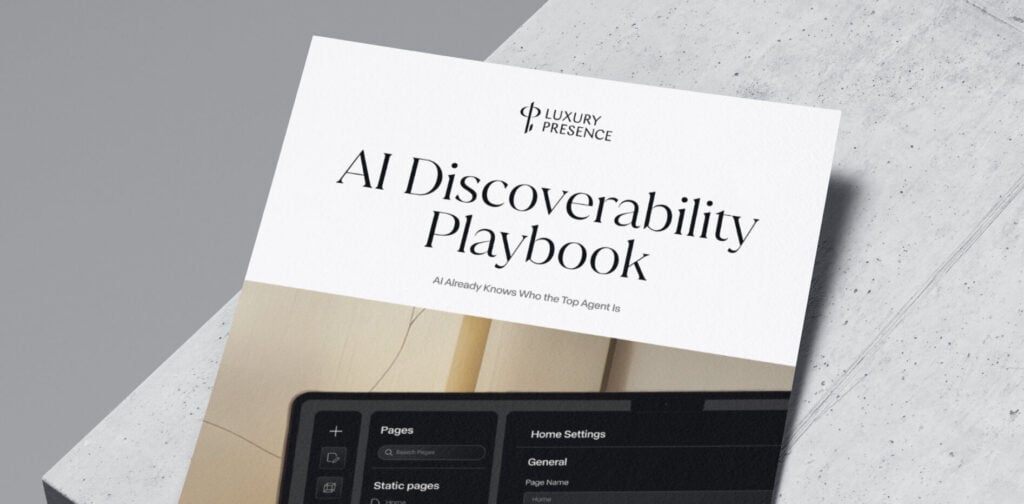
Because AI is Directing the Flow of Search and Recommendation
This playbook exists because the way consumers find real estate professionals is changing, faster than most in the industry realize. And understanding that shift is what gives you an edge.
In 2022, they Googled.
In 2023, they followed Instagram.
In 2024, they asked ChatGPT.
In 2025, LLMs like Gemini, Perplexity, Claude, and GPT-4o are a gateway to decision-making.
A 2024 Gartner report projects that by 2026, over 80% of enterprises will have adopted generative AI technologies, significantly transforming how business and service discovery occur and reducing reliance on traditional search channels.
A McKinsey report highlights that AI-assisted queries and tools are accelerating decision-making processes, enabling more efficient business outcomes compared to traditional browsing.
This shift has major implications for real estate.
If you want AI to recommend your name, build the digital presence that earns it.
What You’ve Learned
We showed you exactly how to reverse-engineer that answer. Each of the six Strategies represents a signal that large language models detect, trust, and reward:
- Run an AI-Optimized Website
→ So AI can read, parse, and extract meaning from your pages, cleanly and confidently. - Publish Unique, Data-Rich Content
→ So the models see you as a source of new insights, not just recycled SEO. - Use Structured Formats & Citations
→ So your content aligns with how AI packages its answers and you’re easy to quote. - Earn Press Mentions
→ So others validate your expertise, giving AI permission to do the same. - Stack Online Reviews
→ So AI sees a pattern of trust from the crowd and learns your reputation from the language they use. - Secure a Wikipedia Page (If/When Possible)
→ So you become an indexed entity in the highest-authority knowledge source on the internet.
Each of these can stand alone. But together, they create a digital ecosystem that tells AI:
This person is relevant, reliable, and ready to be recommended.
Time to Get Started: Work the Playbook
Here’s what we know: This opportunity is real, and it’s immediate.
Here’s what else we know: Most agents won’t do it.
But you’ve read this far. You’ve seen the strategy. And you now understand how AI ranks trust.
So now it’s execution time.
Your AI Discoverability Audit
Before you dive into new tactics, take a moment to assess where you stand across the five core strategies:
- AI-Optimized Website: Is your site fast, mobile-friendly, crawlable, and clearly structured with proper tags and hierarchy?
- Unique, Localized Content: Are you publishing content only you could write? Think case studies, local explainers, market insights.
- Structured Formatting & Citations: Are you using clear headings, Q&A blocks, bullet points, and linking to credible sources?
- Press Mentions: Do any third-party publications (local, industry, or lifestyle) reference your name, quotes, or accomplishments?
- Online Reviews: Are your reviews recent, specific, and spread across platforms like Google, Zillow, Yelp, or Realtor.com?
- If applicable, your Wikipedia Presence: If you meet notability standards, are you working toward a neutral, properly sourced Wikipedia page?
First Steps: Prioritize and Act
You don’t need to overhaul everything at once. Start where the impact is greatest. This playbook is about progress that compounds. Stay consistent, stay visible, and over time, you’ll become the agent AI trusts to recommend.
- Choose your weakest strategy, the one that’s least developed or currently stalled. That’s your next quarter’s focus.
- Set one clear goal for that strategy, e.g., “Launch a local market blog series,” or “Pitch one local news outlet this month.”
- Block time weekly to move it forward. Even 30 minutes a few times a week compounds.
- Track your progress monthly. Make it visible on your calendar, whiteboard, or team dashboard.
- Once that strategy is solid, move to the next. Small wins build momentum, and the stack effect is real.
How Luxury Presence Can Help
Standing out in this new landscape requires more than a website or basic SEO. It demands an intelligent, always-on strategy that makes you the obvious answer when someone asks ChatGPT, Gemini, or Claude: “Who’s the top real estate agent in [your market]?”
That’s exactly what Luxury Presence delivers.
With our AI Marketing Specialists, you’re equipped with a full marketing team, without the overhead of hiring one. Each AI Specialist is purpose-built to handle a core function of your growth:
- The AI SEO Specialist keeps your website aligned with the latest search trends, optimizing your titles, headings, and metadata to help you rank higher on Google and AI engines alike.
- The AI Blog Specialist produces local, data-driven content that large language models (LLMs) love to cite, expanding your digital footprint with fresh, authoritative insights.
- The AI Advertising Specialist runs and optimizes ad campaigns 24/7, shifting your budget toward top-performing strategies, and now includes multi-channel retargeting across Google, YouTube, and Meta.
- The AI Lead Nurture Specialist (Alex) follows up with every new lead automatically, qualifies them using smart conversation flows, and hands them off when they’re ready—so no opportunity gets missed .
All of this runs behind the scenes, fully managed by our in-house team. You’ll see every action, every optimization, and every result inside your Proof-of-Work dashboard and weekly digest emails, so you always know what’s working.
It’s not just about being found. It’s about being chosen.
We’ve built the infrastructure, intelligence, and automation to help you win in an AI-first world, without the complexity or guesswork. Whether you’re looking to scale your brand, generate more leads, or simply stay competitive, Luxury Presence makes it possible.
Let’s make sure that when the next client asks AI who to trust in your market…
You are the obvious answer.
AI Marketing Specialists
Your team behind the scenes. Smart. Seamless. Relentless.

About the author

Chris Linsell
Chris Linsell is a hands-on real estate professional with more than 13 years of experience buying and selling anything from modest starter homes to massive waterside compounds. As a digital and content strategist, he’s worked with teams (real estate and non-real estate alike) to realize their lead generation and overall business goals by finding new ways to demonstrate their expertise and authority in their local markets. Chris Linsell is currently the Director of Content for Luxury Presence. In this role, Chris leads a team of content professionals telling the stories of Luxury Presence’s products, services, and people. A former Senior Writer and Technology Analyst for The Close, the internet’s leading source of actionable, strategic insight for and by industry professionals. Chris’ job was to remain up-to-date on the latest and greatest technology platforms, real estate strategies, and best practices that the leaders of our industry are using to buy and sell more homes every year.


